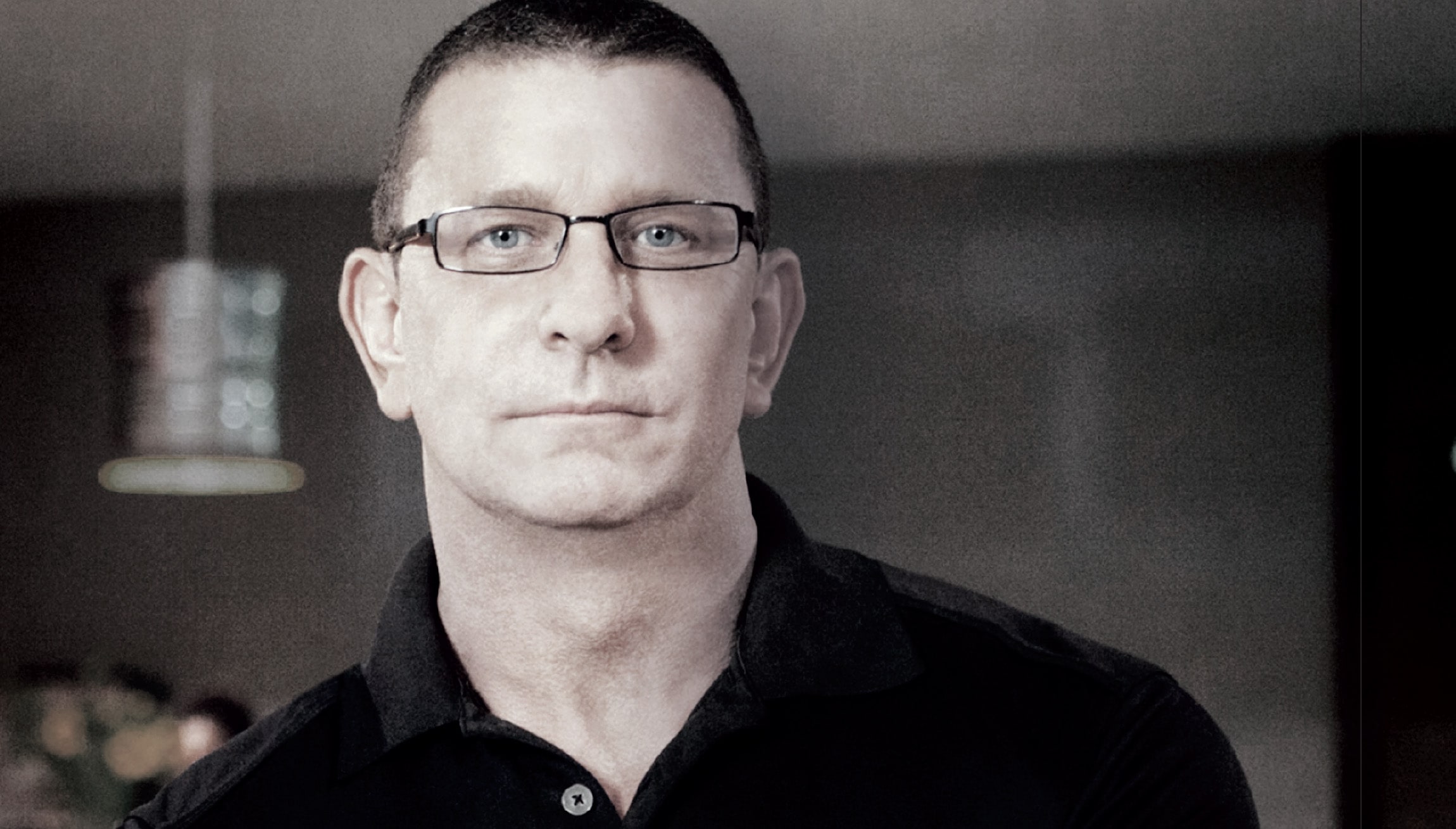
For much of the year, chef Robert Irvine and his modest crew – including a sous chef, construction manager, a rotating designer and a producer or two travel the country to revamp, refresh and revitalize failing restaurants – and often the owners themselves. The camera crews are there to film the action for his TV programme Restaurant: Impossible.
And action it is. Irvine’s reputation for a tough love approach, not without its confrontational words and the occasional shouting match, has drawn devoted fans and strong critics alike. His fans, though, can see through the initial brashness. In most episodes Irvine plays the therapist, listening to his restaurant owner clients and in many cases helping to mend broken families and relationships. In the end there are always hugs all around.
The show begins with meeting the owners and an assessment of the problem. Then there’s a food tasting and menu revamp, a complete gutting and redesign, staff training, marketing support and more – taking place in all of 36 hours before the final reveal. The show and Irvine’s demeanor might seem like an act, but he knows nothing about the restaurant before showing up at the doorstep.
“I want the show to be real – that’s why I don’t learn about the restaurant or family beforehand. I think that’s the main reason for the show’s success,” Irvine says.
“When you see me upset, angry, happy or frustrated, I’m not being fake for the camera. That’s one thing I’ve been most adamant about in my TV career.” Restaurant owners apply online to be a part of the show, but the ultimate decision rests with the show’s staffers.
Once the decisions have been made, Irvine is given the address and that’s it. In most cases, this is the end of the line for the restaurant owners before they have to close. In others, it’s even more serious.
“I take it [their struggles] very personally that’s why I’m so hard on the owners and on my team,” Irvine says. “Because if the restaurant fails they could lose their house, their marriage, their kids.”
Sometimes personal issues and mental illnesses, not just bad business decisions, cause the failures. This is where Robert Irvine, therapist, comes into play. He once had to deal with a situation where the dad had shot himself; another where someone was battling with the pain of a recent sexual assault.
“We don’t show these things on TV,” says Irvine, noting that he’s vehemently opposed to “sensationalised” coverage. Irvine claims 87% of the 118 restaurants they’ve helped revamp have gone on to see continued success.
“If you had asked me three years ago if I would be attached to the families on the show I would have said you have to be joking,” says Irvine. Truth is, he is committed to the families during the transformation process both on and off screen over the long haul
Leadership, loyalty, integrity
Irvine learned about discipline and determination while serving in the British Royal Navy. He joined at just 15 years of age. Though he worked as a chef during his more than 10 years of service – including time aboard Her Majesty’s Royal Yacht Britannia – his love of cooking started even before then, at the age of 11 growing up in Wiltshire, England. After leaving the navy he continued to hone his skills working aboard cruise ships and in hotels and restaurants throughout Europe, the far east and Caribbean.
“Cooking in the military at a young age helped me tremendously,” says Irvine. Reading between the lines, this means taking mediocre, packaged ingredients and making great food out of it. “It was also a huge influence in my life from the standpoint of leadership, loyalty and integrity,” he adds.
Those three words, along with discipline, are what continue to motivate Irvine on – and off – the road. They move him to hit the gym seven days a week for some quality “me-time” where he can reset the mind. Just the week before our interview, Irvine had jumped out of a plane with 20-year-olds from the US Army 82nd Airborn Division (for the record: he’s 50). It’s no surprise, then, that in 2012 he married professional wrestler and former WWE reigning champion Gail Kim, whom Irvine calls the “most amazing person on the planet”. His two teenage daughters are also a source of constant inspiration.
“I believe in a correlation between cooking with family and working out with family – whether that’s taking the kids for a walk or playing hoops,” he says. This dedication to families continues through the Robert Irvine Foundation, which has raised funds for children of military families and those battling cancer.
“We travelled 150 days last year working with the military in Afghanistan, Abu Dhabi and throughout other parts of the world and US,” Irvine says.
He’s also cooked for 1,000 people at the Tuskegee Army Air Field in Alabama to celebrate the base’s 60th anniversary. He’s partnered with actor and head of the Lt. Dan band Gary Sinise for a 6,000-person dinner to raise money for wounded warriors and their families. More than just philanthropy, Irvine says the work is also “about modernising military foodservice as we know it”.
Case in point: Irvine also spent plenty of time on military bases during his first Food Network show, Dinner: Impossible, which aired from 2007 to 2010. In the show, Irvine tackled the seemingly impossible – creating, cooking and serving a delicious dinner for 1,000, 2,000 or even more diners – often at a military base with mediocre ingredients, a limited timeframe and resources, and no advance knowledge of the event. In all 83 episodes, Irvine proved any unbelievers wrong.
Making the impossible possible
Restaurant: Impossible premiered on 19 January, 2011, as a spin-off from Dinner: Impossible produced jointly by Irvine and former Double Dare host Marc Summers. Since then, Irvine has transformed more than 160 restaurants across the US.
Every show opens with Irvine walking into a restaurant, sporting black-rimmed glasses, salt and pepper buzzed hair and a wide, toothy smile. He often wears a short-sleeve polo shirt exposing his beefy, “21-inch” biceps – evidence of that regular gym time. His British accent is immediately apparent and his smile grows wider when he gets to use his trusty sledgehammer to break down a wall. It’s endearing, really, if not a little spine straightening. But that’s the point.
“We’re all in this together,” Irvine says. As a viewer, you feel very much a part of everything, too. Each episode also includes Irvine’s first and extremely important question:
“How much restaurant experience do you have?” More often than not, the answer is ‘none’. “OK, what were last year’s revenues?” Irvine continues. The owners usually have no idea. Their debts and monthly losses are usually enough to scare the average businessperson let alone viewer.
Irvine can then usually be seen cocking his head, showing a slight grin of disbelief and then pondering with his index finger across his mouth. “Hmm.” After a few more questions, he’ll “want to see a service”. Community members are brought in to fill the space and stage a lunch or dinner run-through. “Off you go,” he says.
That’s when disaster really strikes
What makes the restaurant remake an “impossible” challenge, therefore, is not just the task of rebuilding a space on a limited budget and timeframe, it’s the sheer lack of knowledge or experience, and often complacency, of the owners.
They’ve lost their passion. Their families are falling apart. And it shows. Irvine has to help them not only mend their relationships and find that passion again, but teach them how to run a restaurant and train them to survive in what is basically a “new” job for them. “It’s all about taking them back to basics,” says Irvine. “You have to understand what a plate of food costs, what the labour costs. You can teach someone with no knowledge, but you can’t teach common sense overnight. “We know our food should be cooked to a certain temperature, but we don’t do it. We know how to clean but we don’t do it’.”
Dirtiness is Irvine’s super pet peeve, maybe even more than bad food. “Do you keep your house this dirty?” he often asks the owners. “If your house looks like this, then I’m not going to go in your house.” It shows laziness – an “I’ve given up” mentality. If Irvine gets up on a chair to see the dust accumulating on the ceiling fans or shelves, there’s a problem. At certain points he’ll sit down with the owner, family and staff, individually and together, for a heart-to-heart to find out what’s behind what’s going on. In one scene, Robert switches seats from a head-on position to sit in between two hurt sons who want to talk about living with their overly critical father.
In another, he helps a husband tell his wife about the massively accumulating debt he kept secret, among other things. The restaurant always falls second to these situations – in Irvine’s view. But once those personal struggles are on the road to repair, that’s when the restaurant reparations can begin.
Menu makeover
Watching Irvine taste the food is a treat. Typically he’ll sit down at a big table, ordering various dishes to taste at once. Afterwards Irvine often calls – no, yells – for the restaurant owners to come hither. Quickly. That’s usually followed by a “your food is crap” in so many words. Or “this is your passion?” It’s direct, but necessary.
Later, he’ll join the owners in the kitchen to retrain on a new menu that plays off the old but brings it into the modern era. Less is more when it comes to menu design, Irvine believes. “A good restaurant has 10 entrees max,” he says. “Maybe a couple of soups, a few salads, some specials, desserts and appetizers. I’ve dealt with one restaurant on the show that had 600 menu items.”
Irvine also takes a close look at the skill level of the cooks and employees, the kitchen set-up, equipment and other parameters to create a menu that can be executed consistently within what exists.
During the show, Irvine will conduct a demo and tasting for the new menu with the owners and cooks in the kitchen.
When Irvine does his “happy dance” (dancing round in a circle) after taking his first bite, you know the food’s good. More often than not the owners join in.
“Restaurants can’t survive on just the same customers who have been going there for the last 20 years,” Irvine says, referencing a recent episode featuring a decades old bowling alley where the regulars started passing away. “You have to evolve – you can’t keep the same burger on the menu because Mr Smith who has becoming for years likes it. You have to bring in new blood, not only in terms of the staff, but also the clientele.”
Revamping the space
Gutting and rebuilding a restaurant in just 36 hours is a seemingly impossible feat. Irvine realises that, careful to remind us he doesn’t do things alone. Though Irvine will weigh-in with design ideas and of course, what he does not like.
Each episode he’s backed by one of the show’s designers. The crew works overnight, even when the cameras are turned off. With a limited budget, they get creative, making wall art out of clothes hangers or bar facades out of barn doors.
Often, volunteers from the neighbourhood will help in the clean-up and revamping efforts. Tom Bury serves as Irvine’s right hand man, essentially making dreams come to life. Even he gets the brunt of Irvine’s wrath. “TOM!” Irvine will shout if the floor isn’t ready fast enough. Still, in one ‘behind the scenes’ episode Irvine goes on about how he loves Tom and admires his work. So, it’s all good.
The designers also have their distinct styles and funny interactions with Irvine – getting yelled at endearingly on camera, scoffing at his requests or helping knock down walls with that sledgehammer. After the fi nal reveal it’s not uncommon to see the owners hugging and crying in the arms of Irvine and designers.
It’s a wrap – or not…
Eventually, it’s time to train the cooks on execution and food safety, the staff on service (often played out on air through team-building and information-sharing exercises) and the restaurant owners on monitoring and managing their costs, revenues and pro fits.
Irvine’s clients go home with a booklet documenting the menu changes, with recipes and photos as well as basic information about recipe costing, budgeting and other business matters, plus complete contact information for follow-ups.
Even after the cameras are turned off, Irvine says he remains in close contact with his restaurant owner clients. In fact, he receives many emails a day, inbetween the occasional phone calls. Just that week, he had been in contact with former clients Sapori D’Italia in Phoenix, The Main Dish in Alabama and another restaurant in Pennsylvania.
While some restaurants don’t work out, most go on to see some success. Then there are restaurants such as Dodge City in Harrisburg, Pennsylvania, Salt Works II in Wilmington, North Carolina, and countless others that have done really well, he notes.
“I know their anniversaries, their kids’ birthdays,” Irvine says, talking about the personal connections he forges with many clients. The Food Network even aired a special reunion show where Irvine beamed when meeting up with his clients in person again.
“I’m not in the business of making good TV and then walking away and leaving people to fail – that doesn’t work with me,” he says.
Irvine doesn’t apparently have enough on his plate. He recently began filming a new show, Restaurant Express, in which each week contestants travel by bus to challenging cooking locations – such as beaches and zoos – where they’re tested on the various skills required for restaurant business success.
The last contestant standing wins the opportunity to help launch a brand new restaurant in Las Vegas.
He’s also the author of two cookbooks, Mission: Cook! (2007) and Impossible to Easy (2010) while also operating his own restaurant in South Carolina, Robert Irvine’s Nosh.
And here’s a little known fact about Irvine: although he’s cooked all types of cuisine all over the world, he still prefers a classic roast chicken and mashed potatoes. This would be his last meal if he had to choose, he says. And the person to cook it? “My wife”.
Now that’s the real deal.




